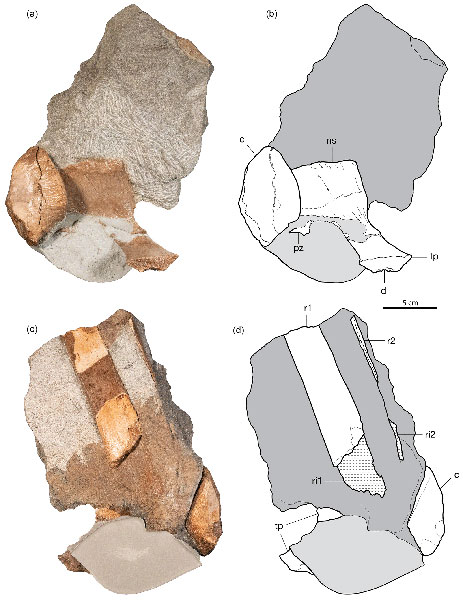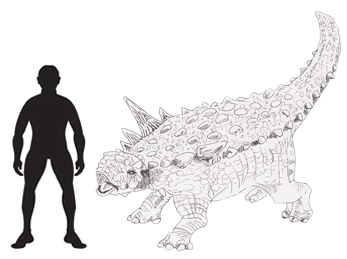An Armoured Dinosaur from British Columbia
Body Fossils of an Ankylosaurian Dinosaur from British Columbia
A small sandstone block containing the back end of a single, fragmentary dorsal vertebra, a dorsal neural arch and two pieces of rib, probably fossils from one animal, have been identified as the fossilised bones of an armoured dinosaur. This material, originally collected in 1930, is one of just a handful of dinosaur bones known from the early Late Cretaceous of Canada (Cenomanian faunal stage). Although fossilised footprints associated with ankylosaurian dinosaurs are known from the area, these are the earliest reported body fossils from the Dunvegan Formation of British Columbia and as such these bones may provide palaeontologists with a new perspective on the transition of dinosaur biotas into the Late Cretaceous of North America.
Fossil Material Identified as Ankylosaurian

Picture credit: Arbour et al (Fossil Record)
Armoured Dinosaur Bones Collected in 1930
The specimen was collected by the Canadian geologist Merton Yarwood Williams in 1930 during a geological survey of the area of the “Peace River district”. Charles M. Sternberg later identified the fossil material as representing an ornithischian dinosaur resembling Camptosaurus.
It was loaned to the Royal Ontario Museum for preparation and study and as part of the research, several members of the scientific team visited the area where the fossil was discovered in an attempt to relocate the original site. Unfortunately, high river levels prevented an extensive search of the steep sided riverbanks. The team did find a number of plant fossils and a natural cast of a dinosaur footprint – Tetrapodosaurus, an ichnogenus believed to represent an ankylosaurian. Dinosaur footprint fossils are associated with this area, many of these tracks are thought to represent armoured dinosaurs.
Details of the Ankylosaurian Vertebrae (British Columbia)

Picture credit: Arbour et al (Fossil Record)
The Dunvegan Formation
The Dunvegan Formation outcrops in both northern Alberta and British Columbia, it is primarily composed of marine strata and deposits laid down in a near-shore delta environment. Vertebrate fossils are rare but shark and teleosts (bony fish), fossils have been found, including one remarkable discovery of a bony fish found in a 75 mm diameter oil drill core – Tycheroichthys dunveganensis.
To read about this serendipitous fossil fish discovery: Amazing Fossil Fish Found in Canadian Oil Drill Core.
These fragmentary remains (CMN 59667), are the only body fossils of an ankylosaurian known from British Columbia, although a few dermal scales and ossicles from an outcrop of the Dunvegan Formation in Alberta have been ascribed to an armoured dinosaur. It is difficult to date the sediments accurately, but the fossils are approximately 99-96 million years old.
What Sort of Ankylosaurian Was It?
CMN 59667 has been identified as ankylosaur material based on a number of traits and characteristics observed in the vertebrae. Although ankylosaur fossils are known from roughly contemporaneous strata in the United States, these types of dinosaurs are not common components of the associated dinosaur fauna.
The body fossils are too fragmentary to confidently assign them to either a nodosaurid or an ankylosaurid ankylosaur. The fossils are still highly significant, terrestrial Cenomanian assemblages are rare in North America but those fossils that have been found provide evidence of an important time in our planet’s history when there was a considerable faunal turnover between the end of the Early Cretaceous and the earliest Late Cretaceous.
A Scale Drawing of the Roughly Contemporaneous Animantarx from the Cedar Mountain Formation of Utah (USA)

Picture credit: Everything Dinosaur
Potentially Providing Important Information on Faunal Turnover
The discovery of skeletal fossils from the Pine River demonstrates the potential for the Dunvegan Formation to produce terrestrial vertebrate fossils that may provide important new data on this significant transitional period during the Cretaceous. The researchers hope that the discovery of more body fossils from this location will help them to make a more specific identification as to what sort of ankylosaurian dinosaur roamed this part of British Columbia.
To read about the discovery of a leptoceratopsid, the first unique dinosaur from British Columbia, that was named and described by two authors of the ankylosaurian scientific paper: A New Leptoceratopsid Ferrisaurus sustutensis from British Columbia.
The scientific paper: “An ankylosaurian dinosaur from the Cenomanian Dunvegan Formation of northeastern British Columbia, Canada” by Victoria M. Arbour, Derek Larson, Matthew Vavrek, Lisa Buckley and David Evans published in the Fossil Record, an open-access journal of the Museum für Naturkunde.
The Everything Dinosaur website: The Website of Everything Dinosaur.

